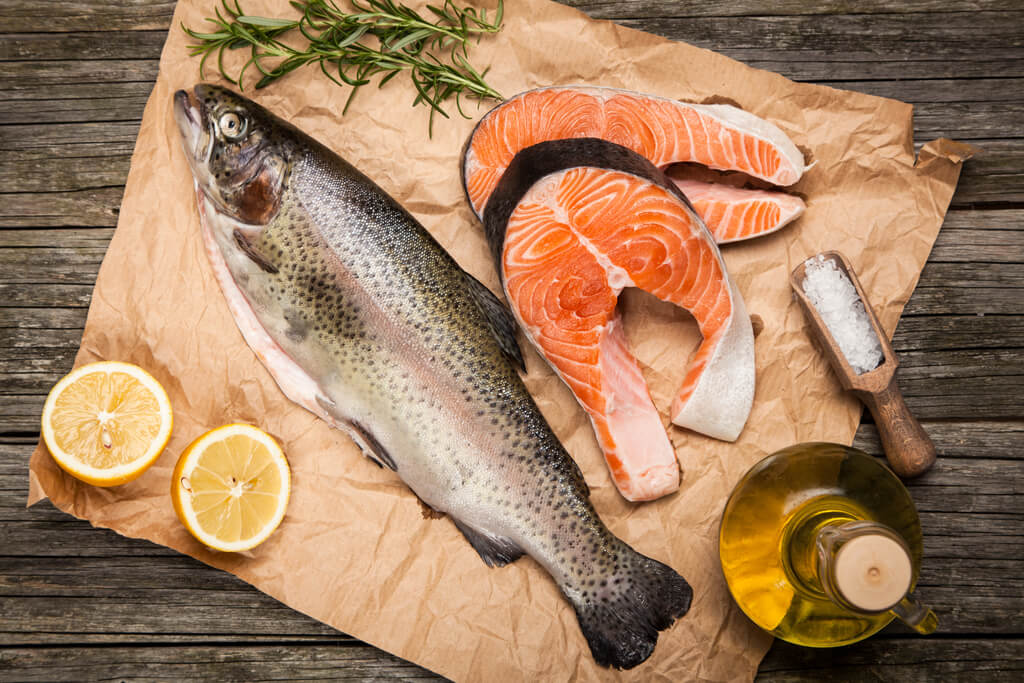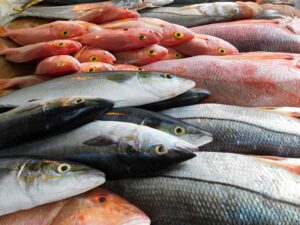Delving into the nuances of two remarkable aquatic species, Ørret and Laks, is not just an exploration of their differences but an unveiling of their significance in the culinary, ecological, and cultural realms. Understanding the variances between these species opens doors to appreciate their unique traits, culinary uses, and crucial roles in both natural ecosystems and human societies.
Ørret: Characteristics and Traits
Ørret, commonly known as trout, is a fascinating species renowned for its diverse characteristics and distinctive traits. Within the family of Salmonidae, Ørret comprises several subspecies, each exhibiting unique attributes that contribute to its overall significance in various ecosystems and culinary traditions.
Size, Appearance, and Behaviors:
One of the primary features distinguishing Ørret is its diverse size range and appearance. These fish generally exhibit a streamlined body shape, with colors varying from olive green to brown, marked with spots along their sides and back. Their appearance can alter depending on their environment, with colors blending to match the surroundings, serving as effective camouflage in the water. Ørret can range in size, from smaller varieties typically found in streams to larger lake-dwelling counterparts. On average, they measure around 12 to 20 inches, though some species can grow significantly larger, reaching lengths of over 30 inches.
In terms of behavior, Ørret tend to be adaptable and opportunistic feeders. Their diet mainly consists of aquatic insects, smaller fish, crustaceans, and occasionally even small mammals. They’re often found in freshwater environments such as rivers, streams, and lakes, where they display a preference for clear, well-oxygenated waters. Ørret are also known for their agility and speed, making them skilled hunters and elusive prey for anglers.

Laks: Characteristics and Traits
Laks, commonly known as salmon, is an iconic and remarkable species that stands out for its distinct characteristics and notable traits. This fish, a member of the Salmonidae family, possesses features and behaviors that distinguish it from other species, particularly from its close relative, the Ørret (trout).
Size, Appearance, and Behaviors
Laks are notably larger than Ørret, often reaching sizes of up to 30 inches or more, depending on the species and environment. Their appearance showcases a robust and streamlined body, usually colored in various shades, ranging from silvery to dark gray or brown on the back. One of the most recognizable features of Laks is its distinct pattern of black spots along the sides, with a silver or white belly. Upon entering freshwater for spawning, their bodies undergo a transformation, displaying vibrant hues, such as deep red or orange.
Regarding behavior, Laks are known for their incredible migratory instincts. Born in freshwater, they migrate to the ocean and spend a significant part of their lives there, only to return to their natal streams for spawning. This remarkable journey involves navigating thousands of miles across open ocean waters, displaying an innate homing instinct that guides them back to the exact stream where they were born. This migration requires exceptional strength and endurance, making Laks one of the most fascinating migratory species in the animal kingdom.

Comparative Analysis: Ørret vs. Laks
A comparative analysis between Ørret (trout) and Laks (salmon) reveals fascinating differences in various aspects, from their physical characteristics to their ecological roles and cultural significance. Understanding these distinctions provides insights into the unique traits of each species and their diverse impacts on ecosystems and human societies.
Physical and Behavioral Contrasts
One of the most apparent differences between Ørret and Laks lies in their physical attributes. Ørret is generally smaller in size, reaching an average length of 12 to 20 inches, whereas Laks typically grow larger, often exceeding 30 inches. This difference in size is complemented by their distinct appearances; Ørret’s coloration tends to be more muted, featuring earthy tones with speckled patterns, while Laks possess a more silvery body with the characteristic black spots on their sides.
Moreover, their behaviors differ significantly. Ørret primarily dwell in freshwater environments, exhibiting adaptability to diverse water conditions, while Laks have an extraordinary migratory nature, spending a significant part of their life in the ocean before returning to their natal freshwater streams for spawning.
Environmental Adaptability and Ecological Impacts
Ørret and Laks display varying adaptability to different habitats. Ørret tend to prefer clear, well-oxygenated freshwater environments such as rivers, streams, and lakes, showcasing their versatility in adapting to diverse conditions within these habitats. On the other hand, Laks demonstrate an incredible capacity to thrive in both freshwater and saltwater environments. Their migratory behavior, from freshwater to the ocean and back, contributes to nutrient cycling, affecting both marine and freshwater ecosystems.
Both species play vital roles in their respective ecosystems. Ørret, as opportunistic feeders, helps regulate smaller fish and insect populations, contributing to the ecological balance of freshwater systems. Laks, through their migration, bring marine-derived nutrients back to freshwater habitats, benefiting the surrounding environment and its inhabitants. Their distinct ecological roles contribute differently to the health and dynamics of the ecosystems they inhabit.

Culinary Preferences and Nutritional Differences
The culinary preferences and nutritional differences between Ørret (trout) and Laks (salmon) offer unique insights into their flavors, textures, and nutritional profiles, making them stand out in various cuisines across the globe.
1) Culinary Preferences:
The culinary preferences for Ørret (trout) and Laks (salmon) are as diverse as the flavors these fish offer, varying significantly due to their distinct taste, texture, and culinary versatility.
Ørret Culinary Preferences:
Ørret, known for its delicate and mild flavor, holds a special place in various culinary traditions. Its versatility in cooking methods allows it to be featured in a wide array of dishes. The subtle taste of Ørret, coupled with its tender and flaky texture, makes it a popular choice for chefs seeking a fish that readily absorbs flavors and complements various ingredients.
Grilling or pan-searing Ørret brings out its natural taste while adding a touch of smokiness. This method enhances its mild flavor without overwhelming the palate. Baking Ørret with herbs and citrus or simply poaching it allows the delicate taste of the fish to shine through. Smoking Ørret infuses it with a unique flavor, adding depth to the overall dish. Due to its more modest size compared to Laks, Ørret is often a feature in local or regional cuisines, celebrated in dishes that highlight its fresh and delicate taste.
Laks Culinary Preferences:
Laks, with its rich, distinct taste and firmer texture, holds an esteemed place in a broad spectrum of global cuisines. Its larger size and robust flavor make it a centerpiece in various culinary traditions. This fish is often the star of celebratory feasts and high-end dining experiences, where its luxurious taste takes precedence.
The versatility of Laks in cooking methods allows it to be showcased in diverse culinary creations. Raw preparations, like sushi and sashimi, capitalize on the fish’s fresh taste and firm texture. Curing or smoking Laks accentuates its rich flavor, making it a sought-after ingredient for creating gourmet dishes. Grilling, roasting, or poaching Laks also highlights its distinct taste while offering endless possibilities in creating sumptuous meals.
Diverse Culinary Applications:
Both Ørret and Laks offer diverse culinary applications, catering to a wide array of preferences and cuisines. Their versatility allows them to be featured in appetizers, main courses, and even as toppings in salads or pastas. Their adaptability in various cooking techniques, coupled with their distinctive flavors, allows chefs and home cooks to experiment and create unique dishes that satisfy a spectrum of tastes.
2) Nutritional Differences
Nutritionally, both Ørret and Laks offer high-quality protein and essential omega-3 fatty acids, contributing to their reputation as healthy dietary choices. However, there are some notable differences between the two in terms of their nutritional content.
Laks generally has a slightly higher fat content compared to Ørret. This difference results in Laks having a richer taste and a higher omega-3 fatty acid concentration. These fatty acids, known for their cardiovascular and brain health benefits, are more abundant in Laks due to its larger size and longer lifespan in the ocean.
Ørret, being smaller and leaner, has a more subtle taste and a lower fat content compared to Laks. It still provides a good source of protein and omega-3 fatty acids, albeit in slightly lower quantities than its larger relative, Laks.
3) Culinary and Nutritional Versatility:
The culinary versatility of both Ørret and Laks allows for a myriad of cooking possibilities and culinary creativity. Their distinct flavors and textures cater to a wide range of preferences, making them adaptable to diverse cultural cuisines.
In terms of nutrition, both fish offer health benefits, providing high-quality protein and omega-3 fatty acids. Their unique nutritional profiles cater to varying dietary needs and preferences, making them popular choices for those seeking a healthy and flavorful diet.
Ørret and Laks in Different Cultures
The significance of Ørret (trout) and Laks (salmon) in various cultures spans centuries, reflecting their diverse roles in culinary practices, traditions, and symbolic importance. Both fish hold unique positions in cultural narratives, shaping cuisines and traditions across different regions.
Scandinavian Cultural Significance:
In Scandinavian cultures, both Ørret and Laks hold profound importance. Laks, in particular, has a notable place in Nordic folklore and mythology, often associated with stories of resilience, transformation, and rebirth. It is also an integral part of traditional Scandinavian cuisine, commonly prepared in various ways, such as gravlax (cured salmon) or smoked salmon dishes. The cultural significance of Laks is evident in the celebrations of events like the midsummer festival (Midsommar), where it takes center stage on dining tables.
Ørret, while equally revered, might have a more regional or localized significance in certain Scandinavian areas. It is utilized in traditional dishes and holds cultural value, though it might not enjoy the same widespread recognition as Laks.
Sustainability and Conservation Efforts
Sustainability and conservation efforts concerning Ørret (trout) and Laks (salmon) have become increasingly imperative due to the challenges these species face, including habitat degradation, overfishing, and environmental pressures. The need for effective conservation strategies is critical to ensure the preservation of these species and their ecosystems.
Challenges Facing Ørret and Laks
Habitat loss and degradation, pollution, climate change, and overfishing pose significant threats to both Ørret and Laks. Increased urbanization, deforestation, and changes in land use have led to the destruction and fragmentation of vital spawning and rearing habitats, impacting the survival and reproduction of these fish. Pollution from various sources, including agricultural runoff and industrial activities, has also deteriorated water quality, affecting the health and well-being of the fish.
Overfishing, both in commercial and recreational sectors, has strained fish populations. This excessive exploitation threatens the natural balance of these species and can lead to declines in their numbers, jeopardizing the health of the ecosystems they inhabit.
Conservation Strategies and Sustainable Practices
To address these challenges, conservation efforts are being implemented on various levels. This includes habitat restoration projects aimed at rehabilitating degraded areas and creating healthy environments for Ørret and Laks to thrive. These projects involve actions such as reforestation, stream bank restoration, and improving water quality through better waste management practices.
Furthermore, the enforcement of fishing regulations and the establishment of catch limits are crucial for managing fish populations sustainably. Regulating fishing practices and seasons, as well as implementing size and bag limits, helps prevent overexploitation and ensures that fish have the opportunity to reproduce and maintain healthy population sizes.
Sustainable aquaculture practices are also being developed to reduce the pressure on wild populations. Responsible fish farming techniques help meet the demand for these species without straining natural stocks. This involves practices such as controlling stocking densities, ensuring appropriate feed and minimizing environmental impacts.
Community Involvement and Future Prospects
Community involvement plays a significant role in conservation efforts. Engaging local communities, conservation organizations, and governmental bodies helps in fostering a sense of responsibility and ownership in preserving the habitats of Ørret and Laks. Educating communities on the importance of these species in the ecosystem and the significance of sustainable practices is crucial for the success of conservation efforts.
Looking to the future, the prospects for Ørret and Laks preservation rely heavily on continued collaborative efforts. Research into innovative conservation techniques, advances in habitat restoration, and the promotion of sustainable fishing practices are essential for ensuring the long-term survival and health of these species.

In Conclusion: Preserving Our Aquatic Treasures
Recapping the significant differences and importance of Ørret and Laks emphasizes the necessity of preserving and understanding both species. Their ecological and cultural significance underlines the urgency in advocating for their conservation and sustainable management.
Frequently Asked Questions (FAQs)
Q1: Are Ørret and Laks the same fish?
A: No, Ørret and Laks are different species, although they belong to the same family.
Q2: Which species is larger, Ørret or Laks?
A: Typically, Laks (salmon) are larger in size compared to Ørret (trout).
Q3: What are the primary differences between Ørret and Laks?
A: Ørret and Laks differ in size, appearance, habits, migratory behaviors, and culinary uses.
Q4: How are Ørret and Laks culturally significant?
A: In various cultures, both Ørret and Laks hold culinary, traditional, and symbolic significance.
Q5: What conservation efforts are being made to protect Ørret and Laks?
A: Conservation efforts include sustainable fishing practices, habitat preservation, and raising awareness about the importance of these species.















